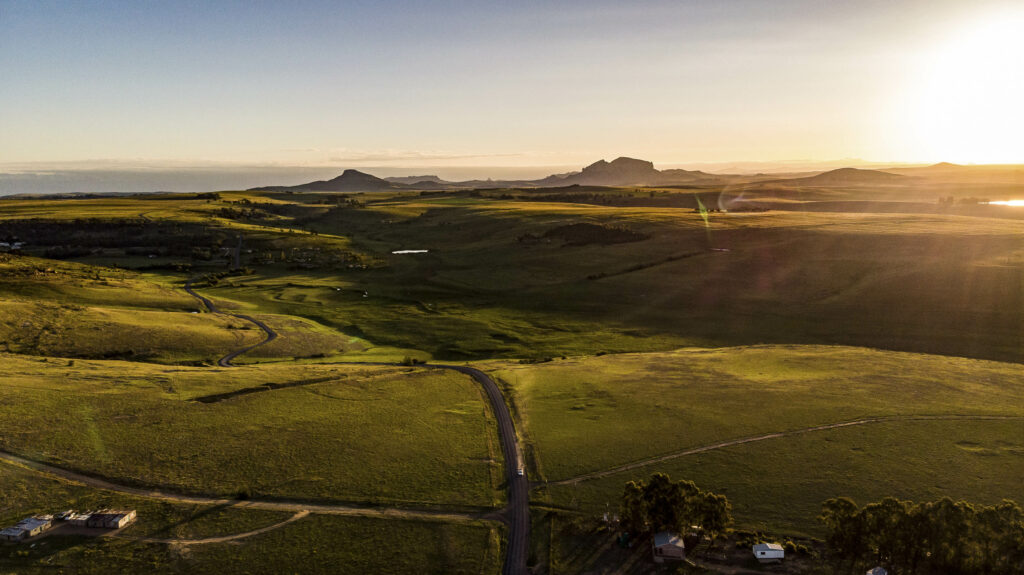Proposed developments imperil the area’s threatened birds including a colony of Cape vultures, bearded vultures, cranes and secretary birds. (Carina Pienaar)
Few people may realise it, but healthy grasslands are crucial for the health and survival of South Africans. They provide grazing for livestock, secure water in the wetlands that supply the major metropoles and regulate the climate by sequestering carbon from the atmosphere.
“And yet this is one of the least protected ecosystems,” says Carina Pienaar, the Ingula and grasslands conservation project manager at BirdLife South Africa.
Only about 2% of the country’s grasslands are formally protected.
Now, with the declaration of the Upper Wilge Protected Environment (UWPE), a safety net has been thrown over 24 000ha of natural high altitude, sourveld grassland and wetland ecosystems in the eastern Free State.
The declaration has been championed by BirdLife South Africa, the Endangered Wildlife Trust, the departments of small business development, tourism, and environmental affairs in the Free State, together with support from the Ingula Partnership, a collaboration between Eskom, the Middelpunt Wetland Trust and BirdLife South Africa.
The wetlands in the UWPE fall in the Northern Drakensberg Water Source Area, which is one of the country’s 22 Strategic Water Source Areas. This means the UWPE makes a considerable contribution to conserving this critical water source, which is used by millions of people, including the residents of Gauteng’s major metropoles.
The declaration, Pienaar says, “means that we are moving one step closer in securing all of the benefits … including securing valuable clean water sources for Gauteng in a time when climate change is disrupting regular annual rainfall and threatening habitat for some of our threatened biodiversity”.

A protected environment is a formal declaration under the National Environmental Management: Protected Areas Act. Through this biodiversity stewardship mechanism, landowners commit to managing their property in a way that ensures the protection of sensitive habitat types on their farms from transformation and disturbances that threaten resident plant and animal species.
Pienaar says the grasslands in the eastern Free State can almost be described as the “meatbasket” of South Africa. “It’s a very important region for the meat industry and livestock production. …. Intact grasslands, as is often the case in the region of the UWPE, and wetlands are crucial in storing carbon stocks.
“The grasslands … have numerous wetlands in the form of pans, unchannelled and channelled valley-bottom wetlands and rivers/streams. All of these systems assist in and beyond the landscape with storing water for slow release into the rivers and dams later on, therefore saving and cleaning water, and preventing downstream flooding.” Pienaar says, explaining that the rain falling in the UWPE eventually reaches the Vaal Dam and joins the Orange River.
Located between Harrismith, Van Reenen and Verkykerskop, the UWPE is a key area for numerous species. This includes vulnerable endemic grassland specialist bird species such as yellow-breasted pipits and southern bald ibises as well as sungazer lizards, endangered species such as grey crowned cranes and critically endangered species such as wattled cranes.
Both the southern bald ibis and yellow-breasted pipit are dependent on good grasslands to be able to breed successfully. “Increasing destruction of grasslands and climate change decreases the likelihood that these species will breed successfully in the region — and not occurring anywhere else in the world — may lead to eventual extinction if their habitat is not protected.
“Our cranes and secretary birds, although they occur elsewhere, require large areas of suitable habitat … for successful breeding and are facing severe threats through the loss of wetlands and grasslands elsewhere in Africa. The UWPE, therefore, provides them with a safe haven,” says Pienaar.
Recent studies on Eskom’s Ingula Nature Reserve, which was declared a Ramsar site under the Convention on Wetlands of International Importance last year, and the UWPE, combined with climate change models, have shown that climatic conditions are critical for successful breeding.
“If the maximum day temperature exceeds a certain threshold — for Ingula and the UWPE this threshold is 32°C — incubating yellow-breasted pipits will leave the nest. If high temperatures continue over several days, it may lead to the nest being abandoned, stopping breeding,” says Pienaar.
The pipits are found at high altitudes where the mean daily temperature is about 25°C, but heatwaves are increasing because of climate change, adding to the threat, she says.
“Climate change models show that high-altitude species are likely to move eastward as the climate may become unsuitable, only the elevation required by these species doesn’t extend into the eastern regions where the climate may be more suitable. It’s crucial to keep the eastern Free State suitable for these species, both from climate and habitat perspectives, as this will most likely be their last resort.”

Sungazer lizards, found in the highland grasslands of the north eastern Free State, are threatened because of their low reproduction rates and habitat destruction, illegal collection for the pet trade and the traditional medicine sector.
The region’s grasslands and wetlands are threatened by mining and oil and gas exploration, overgrazing, the creation of new croplands, ploughing up of virgin grasslands, and erosion.
Specific threats to the UWPE include the proposed construction of the N3 through the De Beers Pass, which “will not only destroy additional grasslands and wetlands, but also pollute the wetlands, threaten the drinking water of Gauteng, and threaten the already threatened species occurring in the region through increased road and other mortalities”.
Proposed wind farm developments, too, imperil the area’s threatened birds including a colony of Cape vultures, bearded vultures, cranes and secretary birds.
BirdLife South Africa, Pienaar says, is assisting the UWPE landowners with the development of a management plan that includes environmental monitoring, ecotourism development, community upliftment and research in the region.
[/membership]